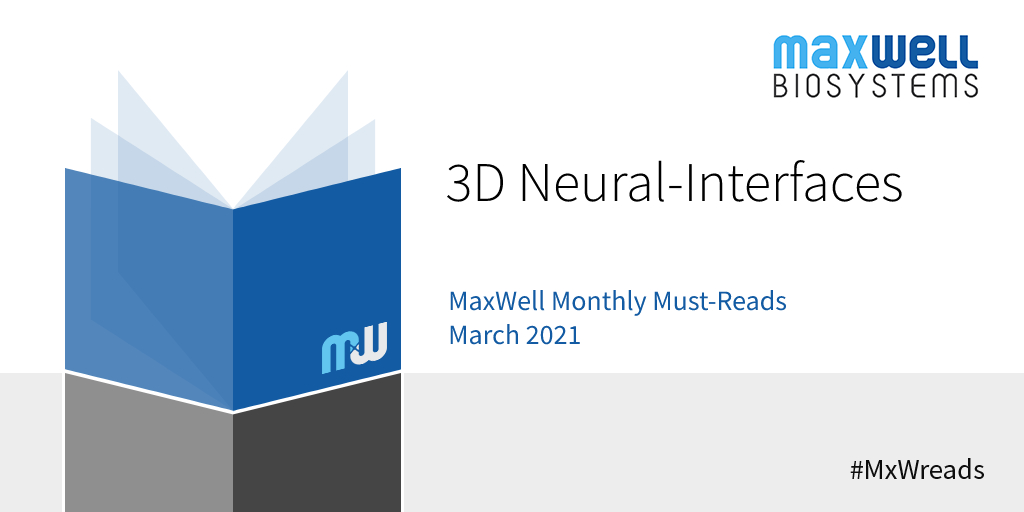It is already time for the last MaxWell Monthly Must-Reads edition of the first quarter of 2021. Last month we focused on the topic of Simulation of extracellular neuronal spiking activity. In this edition we will focus on 3D Neural-Interfaces, and as always we selected five papers that we think are worth reading. Enjoy!
Three-dimensional, multifunctional neural interfaces for cortical spheroids and engineered assembloids.
by Park, Y., Franz, C. K., Ryu, H., Luan, H., Cotton, K. Y., Kim, J. U., Chung, T. S., Zhao, S., Vazquez-Guardado, A., Yang, D. S., Li, K., Avila, R., Phillips, J. K., Quezada, M. J., Jang, H., Kwak, S. S., Won, S. M., Kwon, K., Jeong, H., Bandodkar, A. J., … Rogers, J. A.. Neuroinformatics. July 2020.
Three-dimensional (3D), submillimeter-scale constructs of neural cells, known as cortical spheroids, are of rapidly growing importance in biological research because these systems reproduce complex features of the brain in vitro. Despite their great potential for studies of neurodevelopment and neurological disease modeling, 3D living objects cannot be studied easily using conventional approaches to neuromodulation, sensing, and manipulation. In this paper Park et al. introduce classes of microfabricated 3D frameworks as compliant, multifunctional neural interfaces to spheroids and to assembloids. Electrical, optical, chemical, and thermal interfaces to cortical spheroids demonstrate some of the capabilities. Complex architectures and high-resolution features highlight the design versatility. Detailed studies of the spreading of coordinated bursting events across the surface of an isolated cortical spheroid and of the cascade of processes associated with formation and regrowth of bridging tissues across a pair of such spheroids represent two of the many opportunities in basic neuroscience research enabled by these platforms.
Read the paper here.
Although we decided to highlight the article by Park et al., we selected four other scientific articles that we think are highly relevant to the topic of 3D Neural-Interfaces. These can be found below:
- Cyborg Organoids: Implantation of Nanoelectronics via Organogenesis for Tissue-Wide Electrophysiology.
by Qiang Li, Kewang Nan, Paul Le Floch, Zuwan Lin, Hao Sheng, Thomas S. Blum, and Jia Liu. Journal of Computational Neuroscience. January 2020.
Read the paper here. - A mesh microelectrode array for non-invasive electrophysiology within neural organoids.
by Matthew McDonald, David Sebinger, Lisa Brauns, Laura Gonzalez-Cano, Yotam Menuchin-Lasowski, Michael Mierzejewski, Olympia-Ekaterini Psathaki, Angelika Stumpf, Jenny Wickham, Thomas Rauen, Hans Schöler, Peter D. Jones. Nature Communications. February 2018.
Read the paper here. - A flexible 3-dimensional microelectrode array for in vitro brain models.
by Soscia, D. A., Lam, D., Tooker, A. C., Enright, H. A., Triplett, M., Karande, P., Peters, S., Sales, A. P., Wheeler, E. K., & Fischer, N. OeLife. November 2020.
Read the paper here. - Experimental and Computational Methods for the Study of Cerebral Organoids: A Review.
by Poli, D., Magliaro, C., & Ahluwalia, A.Neural Computation. May 2013.
Read the paper here.
We hope you enjoyed this Monthly-Must-reads! If you would like to be featured in one of the editions, feel free to contact us!
In case you would like to know how MaxWell Biosystems technology can help your experiments, please schedule a call with one of our specialists here: https://calendly.com/mxw
 English
English



